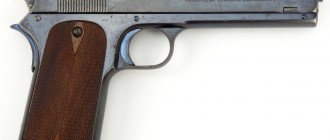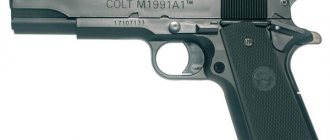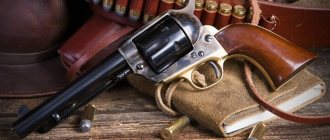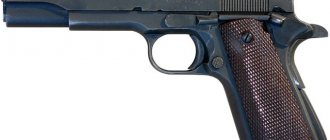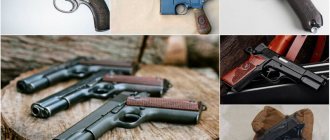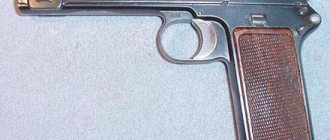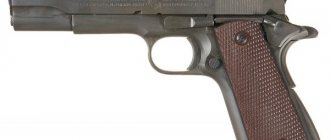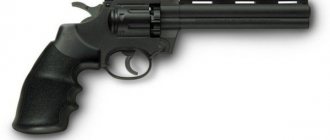| Colt M1900 | |
| Colt Model 1900 | |
| Type: | self-loading pistol |
| A country: | USA USA |
| Production history | |
| Constructor: | John Browning |
| Designed by: | 1897 |
| Manufacturer: | Colt's Manufacturing Company |
| Years of production: | 1900—1902 |
| Total released: | 4274 |
| Cost per copy | US Army, US Navy |
| Characteristics | |
| Length, mm: | 230 |
| Barrel length, mm: | 150 |
| Cartridge: | .38 ACP |
| Work principles: | short-stroke recoil |
| Initial bullet speed, m/s: | 384 |
| Sighting range, m: | 23 |
| Type of ammunition: | 7 rounds |
| Images on Wikimedia Commons: | Colt M1900 |
Colt M1900 Colt M1900 Colt M1900
is the first self-loading pistol, developed by the American John Moses Browning in 1895 - 98, for . Produced by this company from 1900 to the early 1920s.
Device
The action is based on recoil with a short barrel stroke. The barrel is attached to the frame using two earrings, front and back. During the rollback, the barrel, linked to the bolt-casing by three transverse protrusions, moves parallel to the frame, simultaneously decreasing. The protrusions come out of the grooves of the bolt-casing, the barrel stops, the bolt, continuing to move, removes the cartridge case from the chamber, compresses the return and mainsprings, and cocks the hammer. Returning to the forward position under the action of the return spring, the bolt sends the cartridge into the chamber and engages the barrel.
The hammer trigger trigger is single action with a safety cock, which leaves the trigger uncocked if the pistol falls. The mainspring is twisted, cylindrical, located in the handle behind the magazine. The spring-loaded firing pin prevents premature firing when the cartridge is chambered and the barrel is locked with the bolt. There was no shutter stop.
The first release pistols had a safety lock that secured the firing pin. It was turned on by lowering the sight by pressing it down and turned it off by raising it, which was a disadvantage, and since 1901 the safety has not been installed. When the cartridge was in the chamber, it was believed that the hammer was pulled and the safety cocked.
US War Department testing[edit]
In 1899, the US War Department requested designs for semi-automatic pistols and selected three designs for testing; The Mauser C96 "Broomhandle" control recoil, the unusual "forward kick" action of the Steyr Mannlicher M1894 and the Browning designed Colt M1900, which was not ready until after testing began. Testing consisted of accuracy, penetration and reliability tests, ergonomics (or ease of use) tests, and torture tests. Ergonomics were considered very important as the pistol was intended for cavalry use, which meant it had to be easily controlled and reloaded from horseback. Torture tests included a dust extractor and a rust test. [2]Colt M1900 came second in testing due to production delays. [2]Tests began in February 1900. The Colt had a number of initial problems due to poorly fitting trigger parts, which eventually required the attention of a manufacturer's representative who installed a new trigger. Once this was done, the pistol fired the remaining 293 rounds of the 500 allocated for the endurance test, plus an additional 150 rounds without malfunction. Another stock of ammunition, consisting of 350 rounds of low-velocity .38 ACP (935 ft/s (285 m/s)) ammunition, was also tested without any recoil spring adjustments. This was done to test the refurbished trigger mechanism, and although it was expected that it would not work with the pistol configured for 1,200 ft/s (370 m/s) ammunition, only four failures were tested with this ammunition. The pistol produced fired all ten shots without failure during the dust test. After the accelerated rusting of ammonia, the pistol froze so that the bolt did not move. A sharp tap on the edge of the table with the bolt freed it enough to allow the bolt to fire and fire. After firing the first round, the bolt failed to return to battery, but was easily closed, and the remaining rounds worked without failure. All remaining ammunition, 23 rounds, was fired through the rusty cannon without any malfunction. [2]Colt performed well enough during the first round of testing that the board subjected it to additional endurance tests. The 900-round test resulted in only two failures, both misfiring due to defective primers. Additional ammunition was purchased and testing continued. Several link pins were also broken during this test, and in one case, continuing to fire with a broken rear link caused the barrel to separate just behind the front link pin. After firing the pistol a total of 5,800 rounds, the only significant problem was a discovered weakness in the link pins, which was considered easily corrected on the ammo board. The Board recommended purchasing a number of Colt Model 1900 pistols for use in field testing. [2]
Links
Rifles Winchester Model 1885 • Winchester Model 1886 • Winchester 1892 • Winchester Model 1894 • Winchester Model 1895 • Remington Model 8 • Remington Model 24 • FN Trombone Guns Winchester Model 1887 • Winchester Model 1897 • Browning Auto-5/Remington Model 11 • Remington Model 17 • Savage Model 520 • Ithaca 37 Machine guns Colt-Browning M1895 • Browning M1917 • Browning M1918 • Browning M1919 • Browning M1921 • Browning M2 Weapon cartridges .25 ACP • 7.65×17 mm • .38 ACP • 9×17 mm • .45 ACP • 12.7×99 mm
Production[edit]
The Model 1905, .45 ACP, was tested against the .45 caliber Luger pistol variant in 1907. Note the "short" cylindrical hammer on the M1905.
Several variations of the Model 1900 were produced between 1900 and 1923.[3]
- Model 1900. Six-inch (152 mm) barrel, walnut or hard rubber grips, high cylinder hammer, sight safety. Produced in 1900–1903.
- Model 1902 Sporting. Hard rubber grips, without safety, hammer with round or high cylindrical head. Produced in 1902–1908.
- Model 1902 Similar to the 1902 Sporting, but adds a swivel cord at the lower rear of the left handle. Produced in 1902–1929.
- Model 1903 pocket hammer. Similar to the 1902 Sporting, but with a 3 3/4 - or 4 1 ⁄ 2 inch barrel. Produced in 1903–1929.
- Model 1905. Similar to the 1902, but with a 4 7/8 inch barrel, and chambered in the new .45 ACP.
An excerpt characterizing the Colt M1900
“Dismiss the old man to the village, who remains so disgraced that he could not fulfill the great and glorious lot to which he was chosen. I will await your most merciful permission to do so here at the hospital, so as not to play the role of a clerk and not a commander in the army. Excommunicating me from the army will not make the slightest disclosure that the blind man has left the army. There are thousands of people like me in Russia.” “Le Mariechal se fache contre l'Empereur et nous punit tous; n'est ce pas que c'est logique! “Voila le premier acte. Aux suivants l'interet et le ridicule montent comme de raison. Apres le depart du Mariechal il se trouve que nous sommes en vue de l'ennemi, et qu'il faut livrer bataille. Boukshevden est general en chef par droit d'anciennete, mais le general Benigsen n'est pas de cet avis; d'autant plus qu'il est lui, avec son corps en vue de l'ennemi, et qu'il veut profiter de l'occasion d'une bataille "aus eigener Hand" comme disent les Allemands. Il la donne. C'est la bataille de Poultousk qui est sensee etre une grande victoire, mais qui a mon avis ne l'est pas du tout. Nous autres pekins avons, comme vous savez, une tres vilaine habitude de decider du gain ou de la perte d'une bataille. Celui qui s'est retire apres la bataille, l'a perdu, voila ce que nous disons, et a ce titre nous avons perdu la bataille de Poultousk. Bref, nous nous retirons apres la bataille, mais nous envoyons un courrier a Petersbourg, qui porte les nouvelles d'une victoire, et le general ne cede pas le commandement en chef a Boukshevden, esperant recevoir de Petersbourg en reconnaissance de sa victoire le titre de general en chef. Pendant cet interregne, nous commencons un plan de man?uvres excessivement interessant et original. Notre but ne consiste pas, comme il devrait l'etre, a eviter ou a attaquer l'ennemi; mais uniquement a eviter le general Boukshevden, qui par droit d'ancnnete serait notre chef. Nous poursuivons ce but avec tant d'energie, que meme en passant une riviere qui n'est ras gueable, nous brulons les ponts pour nous separer de notre ennemi, qui pour le moment, n'est pas Bonaparte, mais Boukshevden. Le general Boukshevden a manque etre attaque et pris par des forces ennemies superieures a cause d'une de nos belles man?uvres qui nous sauvait de lui. Boukshevden nous poursuit – nous filons. A peine passe t il de notre cote de la riviere, que nous repassons de l'autre. A la fin notre ennemi Boukshevden nous attrappe et s'attaque a nous. Les deux generaux se fachent. Il ya meme une provocation en duel de la part de Boukshevden et une attaque d'epilepsie de la part de Benigsen. Mais au moment critique le courrier, qui porte la nouvelle de notre victoire de Poultousk, nous apporte de Petersbourg notre nomination de general en chef, et le premier ennemi Boukshevden est enfonce: nous pouvons penser au second, a Bonaparte. Mais ne voila t il pas qu'a ce moment se leve devant nous un troisieme ennemi, c'est le Orthodox qui demande a grands cris du pain, de la viande, des souchary, du foin, – que sais je! Les magasins sont vides, les chemins impraticables. Le orthodox se met a la Marieaude, et d'une maniere dont la derieniere campagne ne peut vous donner la moindre idee. La moitie des regiments forme des troupes libres, qui parcourt la contree en mettant tout a feu et a sang. Les habitants sont ruines de fond en comble, les hopitaux regorgent de malades, et la disette est partout. Deux fois le quartier general a ete attaque par des troupes de Marieaudeurs et le general en chef a ete oblige lui meme de demander un bataillon pour les chasser. Dans une de ces attaques on m'a emporte ma malle vide et ma robe de chambre. L'Empereur veut donner le droit a tous les chefs de divisions de fusiller les Marieaudeurs, mais je crains fort que cela n'oblige une moitie de l'armee de fusiller l'autre.
Colt M1911 Specifications
| A country: | USA |
| Year | 1911 |
| Manufacturer | Colt Firearms |
| Countries using weapons | Argentina, Brazil, Bolivia, Colombia, Costa Rica, Dominican Republic, Ecuador, Egypt, Fiji, Greece, Guatemala, Haiti, Indonesia, Iran, Liberia, Malaysia, Mexico, Germany, Nicaragua, Norway, North Korea, Philippines, Spain, South Korea, South Vietnam, Taiwan, UK, USA, Zimbabwe |
| Constructor | John Moses Browning |
| Caliber Colt M1911A1 | 45 ACP (11.43×23 mm) |
| Colt M1911A1 cartridge | 45 ACP |
| Length (total), mm | 2100 |
| Weight (without ammunition), kg | 1,14 |
| Magazine capacity, number of rounds | 7 |
| Initial bullet speed, m/s | 253 |
| Effective firing range, m | 25 |
Learn more about the US Military Colt M1911 Pistol
Colt M1911 Specifications:
- Cartridge: .45 ACP
- Capacity: 7 rounds box
- Muzzle Speed: 835 ft./sec.
- Weight: approx. £2.44
- Length: 8.25 in.
- Barrel length: 5.03 in.
- Action: Short Recoil Operation
Colt M911 Design & Development
In the 1890s, the US Army began searching for an effective semi-automatic pistol to replace the revolvers then in service. This led to a series of tests in 1899-1900, in which examples from the Mauser, Colt and Steyr Mannlicher were examined. As a result of these tests, the US Army acquired 1,000 Deutsche Waffen und Munitionsfabriken (DWM) Luger pistols, which fired the 7.56 mm cartridge. While the mechanics of these pistols were satisfactory, the US Army (and other users) found that the 7.56mm cartridge lacked sufficient stopping power in the field.
A similar complaint was filed by American troops fighting the Philippine Insurrection. Equipped with Colt 1892 revolvers, they found that its .38 cal. the round was not enough to knock down the enemy's charges, especially in the tight confines of the jungle war. In order to temporarily remedy the situation, the senior .45 cal. M1873 Colt revolvers were shipped to the Philippines. The harder the round quickly proved to move effectively. This along with the results of the 1904 Thompson-LeGarde tests led planners to conclude that the new pistol should, at a minimum, fire .45 cal. cartridge.
Looking for a new .45 cal. design, the chief of artillery, Brigadier General William Crozier, ordered a new series of tests. Colt, Bergmann, Webley, DWM, Savage Arms Company, Knoble, and White-Merrill all featured designs. After preliminary testing, Colt, DWM and Savage models were approved for the next round. Despite Colt and Savage introducing improved designs, DWM was elected to withdraw from the competition. Between 1907 and 1911, extensive field testing took place using both Savage and Colt designs. Constantly improved as the process moved forward, John Browning's Colt design ultimately won the competition.
M1911 Design
Browning's M1911 design action is a rollback operation. Like the combustion gases of the bullet disk in the barrel, they also exert a reverse movement on the slide and the barrel pushing them in the opposite direction. This movement ultimately causes the extractor to eject the waste body before the spring changes direction and loads a new round from the magazine. As part of the design process, the US Army determined that the new pistol had both grip and hand safety.
Operating History
Dubbed the .45 caliber M1911 automatic pistol by the US Army, the new pistol entered service in 1911. Evaluating the M1911, the US Navy and Marine Corps accepted it for use two years later. The M1911 saw widespread use with American forces during World War I and performed well. As wartime demands exceeded the colt's production capabilities, an additional production line was established at Springfield Armory. As a result of the conflict, the US Army began evaluating the M1911's performance. This led to several minor modifications and the introduction of the M1911A1 in 1924.
Among the changes to Browning's original design were a wider front section, a shorter drop-off, extended spur safety grip, and a simplified design on the grips. Production of the M1911 accelerated in the 1930s as tensions around the world increased. As a result, the type was the main pistol of American troops in World War II. During the conflict, approximately 1,900,000 M1911s were produced by several companies including Colt, Remington Rand, and Singer. The US Army receives so many M1911s that it does not acquire new pistols for several years after the war.
A highly successful design, the M1911 remained in use with American forces during the Korean and Vietnam Wars. In the late 1970s, the US military came under increasing pressure from Congress to standardize pistol designs and find a weapon that could use the NATO standard 9mm Parabellum pistol cartridge. A variety of testing programs moved forward in the early 1980s, leading to the selection of the Beretta 92S as a replacement for the M1911. Despite this change, the M1911 saw use in the 1991 Gulf War with various specialized units.
The M1911 also remains popular among US special forces units, which carried out variants during the Iraq War and Operation Enduring Freedom in Afghanistan. As a result of their use of the weapon, Army Group Marksman began experimenting with improvements to the M1911 in 2004. Designated the M1911-A2 project, they produced several variants for Special Forces use. The M1911 has been manufactured under license in other countries, and is currently used by numerous militaries around the world.
The weapon is also popular among athletes and competitive shooters. Additionally, the M1911 and its derivatives are used with law enforcement agencies such as the Federal Bureau of Investigation Hostage Rescue Team, numerous local SWAT units, and many local police forces.
